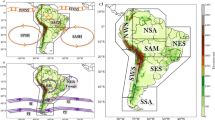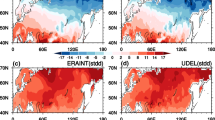Abstract
The relationship between winter cooling in Eurasia and Arctic amplification during the period 1998–2012 under global warming has received increasing attention in recent years. This relationship is controversial and is often studied using model simulations. However, the process of evaluating these models is challenging as a result of the different internal variability among models and between the models and observations. We applied a dynamical adjustment method based on constructed circulation analogs to the model simulations and observations to remove the effects of the internal variability of the atmosphere and then evaluated the performance of the models in simulating the winter surface air temperature (SAT) trends over Eurasia from 1998 to 2012 based on 11 models of the Atmospheric Model Intercomparison Project (AMIP) from phase 6 of the Coupled Model Intercomparison Project. Our results show that the overall performance of all the model ensemble simulations was poor, but was much improved after applying dynamical adjustment, with the median values of the 11 AMIP ensemble simulations fairly close to the observed winter SAT trends averaged over Eurasia. When considering both the model-simulated SAT trends averaged over Eurasia and the skill scores of the trend pattern, the HadGEM3-GC31-LL simulation gave the best performance among the models with multiple runs. This method allows a more objective evaluation of the performance of models and provides an alternative way to evaluate the ability of models to simulate the “warm Arctic and cold Eurasia” trend pattern. The cold Eurasia, especially central Eurasia, in the observations is found to be mainly induced by the contribution from the internal variability of the atmosphere.













Similar content being viewed by others
References
Cattiaux J, Vautard R, Cassou C, Yiou P, Masson-Delmotte V, Codron F (2010) Winter 2010 in Europe: A cold extreme in a warming climate. Geophys Res Lett 37(20):L20704. https://doi.org/10.1029/2010gl044613
Cohen J, Barlow M (2005) The NAO, the AO, and global warming: How closely related? J Clim 18(21):4498–4513. https://doi.org/10.1175/Jcli3530.1
Cohen J, Barlow M, Saito K (2009) Decadal fluctuations in planetary wave forcing modulate global warming in late boreal winter. J Clim 22(16):4418–4426. https://doi.org/10.1175/2009jcli2931.1
Cohen J, Foster J, Barlow M, Saito K, Jones J (2010) Winter 2009–2010: a case study of an extreme Arctic Oscillation event. Geophys Res Lett 37(17):L17707. https://doi.org/10.1029/2010gl044256
Cohen JL, Furtado JC, Barlow M, Alexeev VA, Cherry JE (2012a) Asymmetric seasonal temperature trends. Geophys Res Lett 39(4):L04705. https://doi.org/10.1029/2011gl050582
Cohen J, Jones J, Furtado JC, Tziperman E (2013) Warm arctic, cold continents a common pattern related to arctic sea ice melt, snow advance, and extreme winter weather. Oceanography 26(4):152–160. https://doi.org/10.5670/oceanog.2013.70
Cohen J, Screen JA, Furtado JC, Barlow M, Whittleston D, Coumou D et al (2014) Recent Arctic amplification and extreme mid-latitude weather. Nat Geosci 7(9):627–637. https://doi.org/10.1038/Ngeo2234
Cohen JL, Furtado JC, Barlow MA, Alexeev VA, Cherry JE (2012b) Arctic warming, increasing snow cover and widespread boreal winter cooling. Environ Res Lett 7(7):14007–14014 (14008). https://doi.org/10.1088/1748-9326/7/1/014007
Dai AG, Song MR (2020) Little influence of Arctic amplification on mid-latitude climate. Nat Clim Chang 10(3):231–237. https://doi.org/10.1038/s41558-020-0694-3
Deser C, Terray L, Phillips AS (2016) Forced and internal components of winter air temperature trends over North America during the past 50 years: mechanisms and Implications. J Clim 29(6):2237–2258. https://doi.org/10.1175/jcli-d-15-0304.1
Deser C, Guo RX, Lehner F (2017) The relative contributions of tropical Pacific sea surface temperatures and atmospheric internal variability to the recent global warming hiatus. Geophys Res Lett 44(15):7945–7954. https://doi.org/10.1002/2017gl074273
Ding ZM, Wu RG (2020) Quantifying the internal variability in multi-decadal trends of spring surface air temperature over mid-to-high latitudes of Eurasia. Clim Dyn 55(7–8):2013–2030. https://doi.org/10.1007/s00382-020-05365-5
Easterling DR, Wehner MF (2009) Is the climate warming or cooling? Geophys Res Lett 36(8):L08706. https://doi.org/10.1029/2009GL037810
Gillett NP, Kirchmeier-Young M, Ribes A et al (2021) Constraining human contributions to observed warming since the pre-industrial period. Nat Clim Chang 11:207–212. https://doi.org/10.1038/s41558-020-00965-9
Gong H, Wang L, Chen W, Wu R (2019) Time-varying contribution of internal dynamics to wintertime land temperature trends over the Northern Hemisphere. Geophys Res Lett 46(24):14674–14682. https://doi.org/10.1029/2019GL086220
Guan XD, Huang JP, Guo RX, Lin P (2015) The role of dynamically induced variability in the recent warming trend slowdown over the Northern Hemisphere. Sci Rep 5:12669. https://doi.org/10.1038/srep12669
Guirguis K, Gershunov A, Schwartz R, Bennett S (2011) Recent warm and cold daily winter temperature extremes in the Northern Hemisphere. Geophys Res Lett 38(17):L17701. https://doi.org/10.1029/2011gl048762
Guo R, Deser C, Terray L, Lehner F (2019) Human Influence on Winter Precipitation Trends (1921–2015) over North America and Eurasia Revealed by Dynamical Adjustment. Geophys Res Lett 46(6):3426–3434. https://doi.org/10.1029/2018gl081316
Hartmann DL, Klein Tank AMG, Rusticucci M, Alexander LV, Brönnimann S, Charabi Y, Zhai PM et al. (2013) Observations: Atmosphere and Surface Supplementary Material. In: Stocker TF, Qin D, Plattner G-K, Tignor M, Allen SK, Boschung J, Midgley PM, et al., Eds., Climate Change 2013: The Physical Science Basis, Contribution of Working Group I to the Fifth Assessment Report of the IPCC, Cambridge University Press, Cambridge, 159–254. https://doi.org/10.1017/CBO9781107415324.008
Hersbach H et al (2020) The ERA5 global reanalysis. Q J R Meteorol Soc 146(730):1999–2049. https://doi.org/10.1002/qj.3803
Hirota N, Takayabu YN, Watanabe M, Kimoto M (2011) Precipitation reproducibility over tropical oceans and its relationship to the double ITCZ problem in CMIP3 and MIROC5 climate models. J Clim 24(18):4859–4873. https://doi.org/10.1175/2011jcli4156.1
IPCC (2018) Masson-Delmotte, V. et al (eds) Special Report on Global Warming of 1.5℃. https://unfccc.int/documents/185731
Kaufmann RK, Kauppi H, Mann ML, Stock JH (2011) Reconciling anthropogenic climate change with observed temperature 1998–2008. Proc Natl Acad Sci USA 108(29):11790–11793. https://doi.org/10.1073/pnas.1102467108
Kosaka Y, Xie SP (2013) Recent global-warming hiatus tied to equatorial Pacific surface cooling. Nature 501:403–407. https://doi.org/10.1038/nature12534
Kug JS, Jeong JH, Jang YS, Kim BM, Folland CK, Min SK, Son SW (2015) Two distinct influences of Arctic warming on cold winters over North America and East Asia. Nat Geosci 8(10):759–762. https://doi.org/10.1038/Ngeo2517
Mori M, Watanabe M, Shiogama H, Inoue J, Kimoto M (2014) Robust Arctic sea-ice influence on the frequent Eurasian cold winters in past decades. Nat Geosci 7(12):869–873. https://doi.org/10.1038/Ngeo2277
Mori M, Kosaka Y, Watanabe M, Nakamura H, Kimoto M (2019a) A reconciled estimate of the influence of Arctic sea-ice loss on recent Eurasian cooling. Nat Clim Chang 9(2):123–129. https://doi.org/10.1038/s41558-018-0379-3
Mori M, Kosaka Y, Watanabe M, Taguchi B, Nakamura H, Kimoto M (2019b) Reply to: Is sea-ice-driven Eurasian cooling too weak in models? Nat Clim Chang 9(12):937–939. https://doi.org/10.1038/s41558-019-0636-0
Morice CP, Kennedy JJ, Rayner NA, Jones PD (2012) Quantifying uncertainties in global and regional temperature change using an ensemble of observational estimates: The HadCRUT4 data set. J Gerontol Ser A Biol Med Sci 117(D8):D08101. https://doi.org/10.1029/2011jd017187
Oldenborgh GJV, Drijfhout S, Ulden AV, Haarsma R, Dijkstra H (2008) Western Europe is warming much faster than expected. Clim past Discuss 5(1):1–12. https://doi.org/10.5194/cp-5-1-2009
Overland JE, Wood KR, Wang MY (2011) Warm Arctic-cold continents: climate impacts of the newly open Arctic Sea. Polar Res 30:15787. https://doi.org/10.3402/polar.v30i0.15787
Peng, D., Zhou, T., Zhang, L., Zhang, W., & Chen, X (2020) Observationally constrained projection of the reduced intensification of extreme climate events in Central Asia from 0.5°C less global warming. Climate Dynamics 54(1–2):543–560. https://doi.org/10.1007/s00382-019-05014-6
Petoukhov V, Semenov VA (2010) A link between reduced Barents-Kara sea ice and cold winter extremes over northern continents. J Gerontol Ser A Biol Med Sci 115:D21111. https://doi.org/10.1029/2009jd013568
Raäisaänen J (2016) How reliable are climate models? Tellus 59A:2–29. https://doi.org/10.1111/j.1600-0870.2006.00211.x
Screen JA, Blackport R (2019) Is sea-ice-driven Eurasian cooling too weak in models? Nat Clim Chang 9(12):934–936. https://doi.org/10.1038/s41558-019-0635-1
Screen JA, Simmonds I (2010) The central role of diminishing sea ice in recent Arctic temperature amplification. Nature 464(7293):1334–1337. https://doi.org/10.1038/nature09051
Serreze MC, Barry RG (2011) Processes and impacts of Arctic amplification: a research synthesis. Global Planet Chang 77(1–2):85–96. https://doi.org/10.1016/j.gloplacha.2011.03.004
Slivinski LC, Compo GP, Whitaker JS, Sardeshmukh PD, Giese BS, McColl C et al (2019) Towards a more reliable historical reanalysis: Improvements for version 3 of the Twentieth Century Reanalysis system. Q J R Meteorol Soc 145(724):2876–2908. https://doi.org/10.1002/qj.3598
Sun L, Perlwitz J, Hoerling M (2016) What caused the recent “Warm Arctic, Cold Continents” trend pattern in winter temperatures? Geophys Res Lett 43(10):5345–5352. https://doi.org/10.1002/2016gl069024
Taylor K, E, (2001) Summarizing multiple aspects of model performance in a single diagram. J Geophys Res Atmos 106(D7):7183–7192. https://doi.org/10.1029/2000JD900719
Thackeray CW, Fletcher CG, Mudryk LR (2016) Quantifying the uncertainty in historical and future simulations of Northern Hemisphere spring snow cover. J Clim 29:8–8663. https://doi.org/10.1175/JCLI-D-16-0341.1
Trenberth KE, Fasullo JT (2013) An apparent hiatus in global warming? Earth Fut 1(1):19–32. https://doi.org/10.1002/2013ef000165
Wallace JM, Fu Q, Smoliak BV, Lin P, Johanson CM (2012) Simulated versus observed patterns of warming over theextratropical Northern Hemisphere continents during the cold season. Proc Natl Acad Sci USA 109(36):14337–14342. https://doi.org/10.1073/pnas.1204875109
Wang Y, Huang G, Hu K (2020) Internal variability in multidecadal trends of surface air temperature over antarctica in austral winter in model simulations. Clim Dyn 55:2835–2847. https://doi.org/10.1007/s00382-020-05412-1
Wettstein JJ, Deser C (2014) Internal variability in projections of twenty-first-century Arctic sea ice loss: role of the largescale atmospheric circulation. J Clim 27(2):527–550. https://doi.org/10.1175/jcli-d-12-00839.1https://doi.org/10.1007/s00382-019-05060-0
Zhang XD, Lu CH, Guan ZY (2012) Weakened cyclones, intensified anticyclones and recent extreme cold winter weather events in Eurasia. Environ Res Lett 7(4):044044. https://doi.org/10.1088/1748-9326/7/4/044044
Acknowledgements
This work was supported by the Strategic Priority Research Program of Chinese Academy of Sciences (XDA20020201), the National Natural Science Foundation of China (Grant 41675093) and the Jiangsu Collaborative Innovation Center for Climate Change. We thank the anonymous reviewers for the suggestions. We also thank Dr. Lijuan Li for discussions.
Author information
Authors and Affiliations
Corresponding author
Ethics declarations
Conflict of interest
The authors declare no competing interests.
Data availability
The HadCRUT4.6.0.0 dataset is available online at https://crudata.uea.ac.uk/cru/data/temperature/. The 20CRV3 and ERA5 reanalysis datasets are available online at https://psl.noaa.gov/data/gridded/data.20thC_ReanV3.html and www.ecmwf.int/en/forecasts/datasets/reanalysis-datasets/era5, respectively. The AMIP and corresponding piControl simulations are available online at https://esgf-data.dkrz.de/search/cmip6-dkrz/. The authors express their gratitude to the organizations that provide these data.
Additional information
Publisher's Note
Springer Nature remains neutral with regard to jurisdictional claims in published maps and institutional affiliations.
Rights and permissions
About this article
Cite this article
Xiao, C., Qian, C., Huang, A. et al. Evaluation of AMIP models from CMIP6 in simulating winter surface air temperature trends over Eurasia during 1998–2012 based on dynamical adjustment. Clim Dyn 60, 17–31 (2023). https://doi.org/10.1007/s00382-022-06295-0
Received:
Accepted:
Published:
Issue Date:
DOI: https://doi.org/10.1007/s00382-022-06295-0




